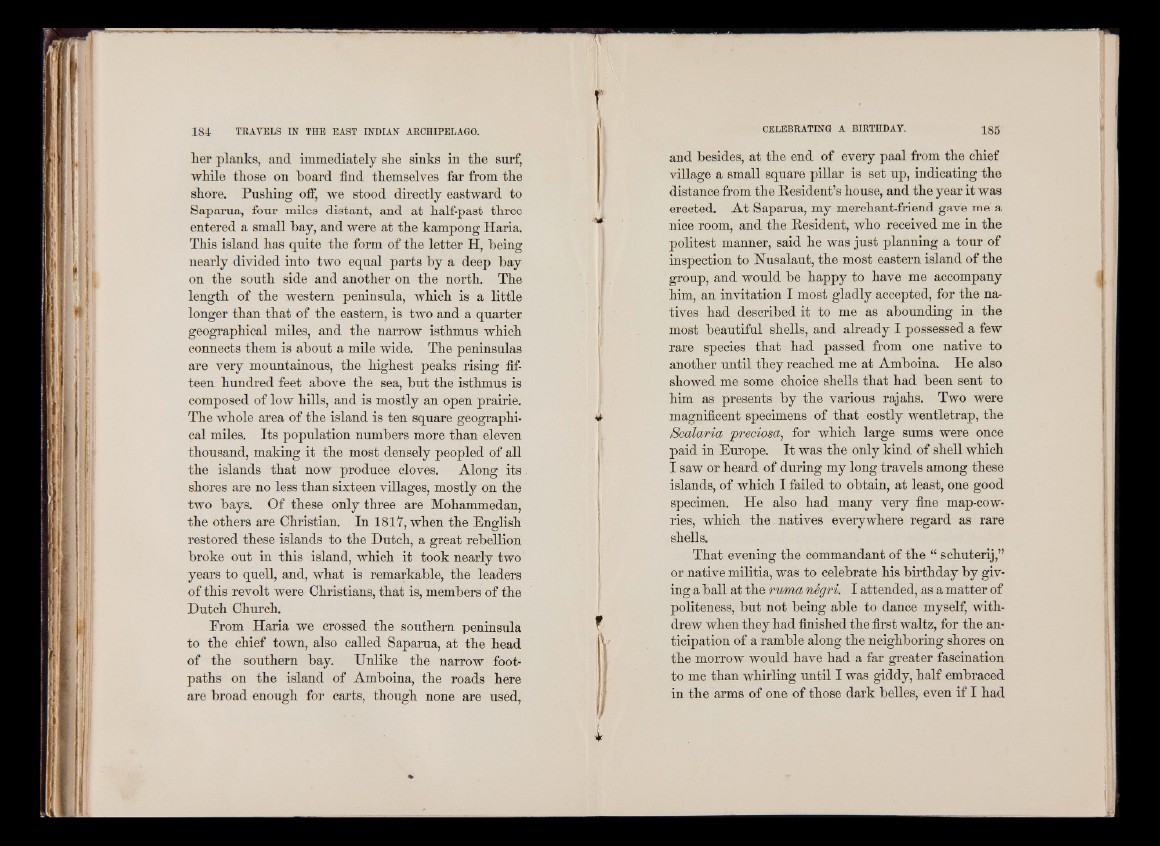
her planks, and immediately she sinks in the surf,
while those on board find themselves far from the
shore. Pushing off, we stood directly eastward to
Saparua, four miles distant, and at half-past three
entered a small bay, and were at the kampong Haria.
This island has quite the form of the letter H, being
nearly divided into two equal parts by a deep bay
on the south side and another on the north. The
length of the western peninsula, which is a little
longer than that of the eastern, is two and a quarter
geographical miles, and the narrow isthmus which
connects them is about a mile wide. The peninsulas
are very mountainous, the highest peaks rising fifteen
hundred feet above the sea, but the isthmus is
composed of low hills, and is mostly an open prairie.
The whole area of the island is ten square geographical
miles. Its population numbers more than eleven
thousand, making it the most densely peopled of all
the islands that now produce cloves. Along its
shores are no less than sixteen villages, mostly on the
two bays. Of these only three are Mohammedan,
the others are Christian. In 1817, when the English
restored these islands to the Dutch, a great rebellion
broke out in this island, which it took nearly two
years to quell, and, what is remarkable, the leaders
of this revolt were Christians, that is, members of the
Dutch Church.
From Haria we crossed the southern peninsula
to the chief town, also called Saparua, at the head
of the southern bay. Unlike the narrow footpaths
on the island of Amboina, the roads here
are broad enough for carts, though none are used,
and besides, at the end of every paal from the chief
village a small square pillar is set up, indicating the
distance from the Resident’s house, and the year it was
erected. At Saparua, my merchant-friend gave me a
nice room, and the Resident, who received me in the
politest manner, said he was just planning a tour of
inspection to Nusalaut, the most eastern island of the
group, and would be happy to have me accompany
h im , an invitation I most gladly accepted, for the natives
had described it to me as abounding in the
most beautiful shells, and already I possessed a few
rare species that had passed from one native to
another until they reached me at Amboina. He also
showed me some choice shells that had been sent to
him as presents by the various rajahs. Two were
magnificent specimens of that costly wentletrap, the
Scalaria preciosa, for which large sums were once
paid in Europe. It was the only kind of shell which
I saw or heard of during my long travels among these
islands, of which I failed to obtain, at least, one good
specimen. He also had many very fine map-cow-
ries, which th e . natives everywhere regard as rare
shells.
That evening the commandant of the u schuterij,”
or native militia, was to celebrate his birthday by giving
a ball at the rvma négri. I attended, as a matter of
politeness, but not being able to dance myself, withdrew
when they had finished the first waltz, for the anticipation
of a ramble along the neighboring shores on
the morrow would have had a far greater fascination
to me than whirling until I was giddy, half embraced
in the arms of one of those dark belles, even if I had